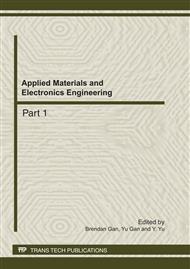p.650
p.655
p.659
p.663
p.668
p.674
p.681
p.688
p.692
Comparison of the Mechanical Properties of Thai Nonlatex with Commercial Latex Orthodontic Elastics for Orthodontic Application
Abstract:
Natural rubber latex products are used as orthodontic elastics but the increased incidence of latex allergies has led to the development of nonlatex orthodontic products. In Thailand, commercial nonlatex orthodontic elastics are not readily available and the cost of imported non latex products is relatively high. Thai non latex elasticshave been developedas alternative orthodontic products for latex-allergic patients and their costs are affordable.Objective: Tocomparethe mechanical properties of Thai nonlatex elastics with commercial natural latex orthodontic elastics for orthodontic application. Materials and Methods: Samples of imported latex orthodontic elastics [Ormco(USA), G&H (USA), Creative Orthodontics (China), Tomy Elastics (Japan)]were selected to compare their dimensional characteristics and mechanical properties with Thai non latex elastics. The dimensional characteristics of the elastics (i.e., inner diameter, cross-sectional thickness and cross-sectional area) were determined and their mechanical properties [(i.e., initial extension force (F0), 24 h- residual force (F24), percentage of force loss, force exerted at 3x the specified inner diameter(F3xID) and breaking force] were tested next. The data were analyzed with One-way ANOVA and multiple comparison by Tukey’s test was used among groups (p<0.05). Results:Significant differences of dimensional characteristics and mechanical properties were found among each brand of elastics. Thai non latex elastics had significantly different mechanical properties from natural latex elastics as reported in previous studies(p<0.05). Thai non latex elastics had the lowest initial extension force (0.82N), 24-h residual force (0.56 N) and breaking force (19.63 N, 8.183 MPa) but the highest percentage of force loss after 24 h (32.62%).However, the percentage of force loss was higher than commercial non latexelastics as previously reported. Conclusion:Thai nonlatex elastics were not comparable to those of the latex elasticsregardingmechanical properties;however,these are acceptable for orthodontic application. Therefore, the clinical selection of elastics should be based on the patient’s medical history and the specific mechanical properties of the type of elastic. Thai nonlatex orthodontic elastics can be a valid alternativefor patients with latex allergy in Thailand and this study contributes to the continuous development of Thai nonlatex orthodontic elastics.
Info:
Periodical:
Pages:
668-673
Citation:
Online since:
October 2011
Keywords:
Price:
Сopyright:
© 2012 Trans Tech Publications Ltd. All Rights Reserved
Share:
Citation:


